Professional Gaming Mice: Razer DeathAdder vs. Microsoft Habu

I guess no one will argue my point if I say there are only three serious contenders on the market of high-quality gaming PC mice. And today we are going to introduce to you the latest products from two of them: Razer and Microsoft. Find out which one is the best choice for gamers today from our detailed comparison.
I guess no one will argue my point if I say there are only three serious contenders on the market of high-quality gaming PC mice, namely Logitech, Microsoft, and Razer.
And the Redmond-headquartered software giant had joined forces with the California-based Razer to develop the recently released Microsoft Habu. Rather oddly, it is a Razer product, the company’s first asymmetric mouse DeathAdder, which is the closest market rival to the Habu.
So, I’ll try to compare them to see which is better. Most exciting is that these two mice are shaped identically, but have quite different technical characteristics.
Let’s take a look at our today’s testing participants:
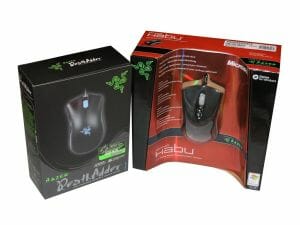
Razer DeathAdder
Specification
- Product name: Razer DeathAdder Nova Blue
- Device type: optical wired mouse
- Sensor: Razer Precision 3G Infrared
- Resolution: 1800dpi
- Buttons: 5 (2+2+wheel)
- Scroll wheel: vertical
- Interface: 16-bit USB
- Default USB polling rate: 1000Hz
- Cord length: 210cm
- Dimensions: 128x70x40mm
Package and Accessories
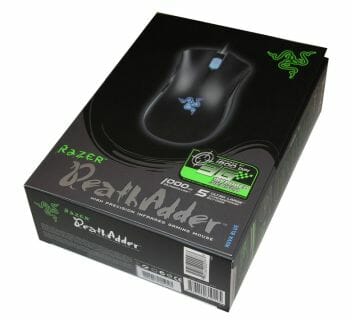
Razer’s history began with the legendary Boomslang 2000 mouse that stood out among its competitors with its superb package design and thought-through overall style, besides other things. Now Razer seems to have worked out unique corporate aesthetic guidelines again. The boxes of their new products (Barracuda, Tarantula, and DeathAdder) stand in a striking contrast to the rather tasteless and unimaginative packages of the Viper, Diamondback, and Copperhead. In some elements this box resembles the package design of the Boomslang 2000, which is a real treat to my eye.
The compact cardboard box is painted black with acid green and gray details. It is all covered with technical and marketing information about the DeathAdder, from a specification in eight languages to a traditional Razerguy’s message (it’s Robert Krakoff, the company’s head and lead ideologist).
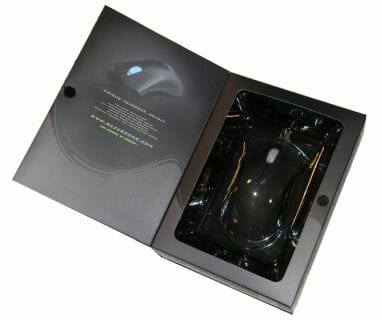
Open the lid and you’ll see the mouse through a plastic window.
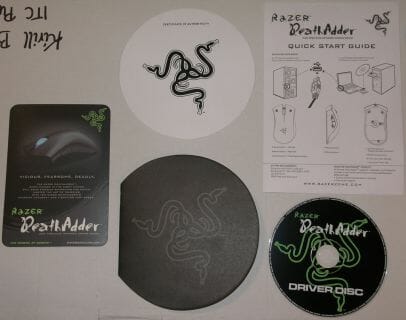
The box contains:
- Razer DeathAdder mouse
- Quick Start Guide
- Certificate of Authenticity
- DeathAdder advertising leaflet
- Master Guide booklet
- CD with drivers
Curiously, the design of the Master Guide (and of the Certificate of Authenticity, too) is very similar to the one that was developed by Fitch Inc. for the Razer Boomslang 2000 with the peculiar shape of the booklet and with the disc fastened on the last page of it (the Boomslang kit is at the top and the DeathAdder kit is at the bottom of the photograph). It is going to be a cause of a fit of fine nostalgia for those who remember how Razer began its way to the peak of the gaming peripheral market.
Design and Ergonomics
The new Razer is designed quite differently from all other models of the company. On one hand, this comes from the product positioning: it is the first mouse from Razer that is not to be wielded with the left hand. The DeathAdder is a right-handed mouse. There is no doubt this model was called for. Many users prefer ergonomic mice and Razer didn’t offer them anything before. On the other hand, Razer has always made compact mice (except for the Boomslang) that were supposed to be held with the fingers only (the Boomslang would be held with the fingers too, but was large and heavy anyway). The DeathAdder is by far larger than the Diamondback and the Copperhead and resembles products from the Microsoft Explorer series (the MS IntelliMouse Explorer 3.0, to be exact), especially with the rear part design. This is not surprising as I’ll explain in the section about the Microsoft Habu.
Being completely black, the DeathAdder looks somewhat simpler than Razer’s other mice or than the Microsoft Habu. But when you connect it to the PC, a Razer logo, almost imperceptible before, begins to pulse in blue. The translucent wheel has blue highlighting, too. This version of the mouse is called Nova Blue and there will probably appear other colors as it was the case with the Diamondback and Copperhead. The mouse driver offers the option of turning the highlighting of one or both LEDs off, which is good for people who often sit at their PC in the dark.
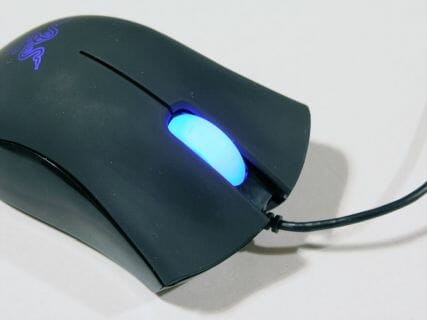
The design of the main buttons has changed since Razer’s previous models which used to have huge black buttons that occupied half the mouse body. The ingenious wavy profile that doesn’t let your fingers slip sideways is retained since the Diamondback, but the right button is below the left one (which is normal for a mouse shaped like that) and the buttons themselves are part of the device’s top panel, which provides a laconic and discreet impression. This panel is made of plastic and is covered with a thin layer of rubberized material which is actually my biggest gripe about the DeathAdder. Surely, it improves the grip between the hand and the mouse and is agreeable to touch, but even if you wash your hands before taking the mouse into them, you’ll find that this material gets greasy quickly (and I couldn’t clean the mouse back to its original appearance after a couple of weeks of use). It is also scratchable and even wears off eventually. Some users have reported that the top coating of their Razer Copperhead, which uses the same coating material, wore off to the plastic in half a year of use. This doesn’t affect the device’s functionality and ergonomics, but I don’t think it’s going to please those people who want to have a neat and tidy work place.
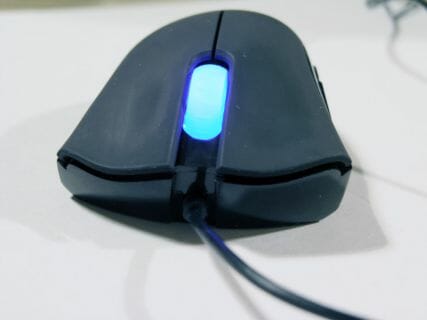
The buttons react nearly uniformly to the press along all of their length, which allows holding the mouse in different ways and not exerting any additional effort to make a click. The buttons’ depression distance is optimal, the pressure effort required is low, but the click is quite perceptible.
The wheel is designed in Razer’s traditional way. Made of translucent white rubber, it is of average width and has a “tread” in the form of deep dents. The wheel moves very accurately. Each step (24 steps per a full rotation) is accompanied with a click, there can be no skipping. The mouse does not support horizontal scrolling, but offers the Universal Scroll feature after you install the driver (horizontal and vertical scrolling by moving the mouse with the wheel depressed).
The current version of the driver (1.03) does not allow replacing the Universal Scroll with just a third button. This shortcoming is expected to be corrected in the next driver release.
Additional side buttons have always been a problem with this manufacturer. It was too easy to press them accidentally on the Boomslang when you lifted the mouse up above the desk. The Diamondback had as many as four side buttons, two of which could hardly be pressed at all. These buttons were placed normally on the Copperhead, but were shaped improperly and prone to be pressed accidentally due to their small pressure effort and short depression distance. And finally the company has got near the ideal. There are two side buttons here which are placed like on the Copperhead (centered on the left side), but larger and round-shaped. They are also to be pressed with more effort. It means you can hardly press them accidentally as you lift the mouse up.
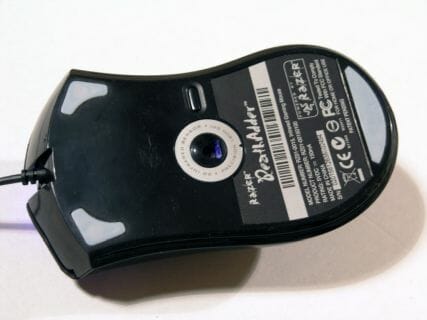
As I wrote above, the overall shape resembles a mix of the Diamondback (in the front part) with Microsoft’s Explorer mouse (in the rear). And although the DeathAdder is not as large as Logitech’s bulky MouseMan series (remember such?), it is surely better grasped with the whole palm rather than with the fingers. I prefer holding the mouse like that and it was at first difficult for me to transition from the Diamondback, which was perfect for fingers, to the DeathAdder. The dimensions and ergonomics of the device may seem to worsen control over in-game situations at first, but I got used to the new mouse in about a week and now play quite confidently with it. The DeathAdder can even be held with fingers too, you only have to adjust yourself to the asymmetrical shape.
On the other hand, I guess that people who like to put their palm down on the mouse, especially the admirers of Microsoft’s peripherals, are going to love the DeathAdder.
The side surfaces are made of smooth plastic which doesn’t improve the grip between the hand and device. There are no rubber inserts as on the Viper or Diamondback, but this problem is solved by the ingeniously shaped profile with grooves for the fingers and the thumb’s resting upon the additional buttons panel. After some period of adaptation the DeathAdder proves to be as easy to carry over above the pad as any other Razer mouse.
There are three white Teflon feet on the device’s bottom: two in the corners of the front part and one wide foot at the back. Their material is typical of Razer mice and is referred to in the marketing materials as “Zero-Acoustic Ultraslick Teflon Feet”, which is in fact what they are. The DeathAdder glides confidently and with less noise than ordinary mice even on complex surfaces like the glass Icemat or the aluminum BansheePad. This mouse moves about just like its competitors do with Teflon glide tapes glued to them.
The engineers made one mistake as they designed the DeathAdder: the bottom surface is not ideally flat, but somewhat bulging. That’s why the central part touches the pad and gets scratched. This doesn’t affect usability, but some people may not like that. You can solve this problem by making the feet thicker by means of special stickers. By the way, Razer says that Everglide, the famous manufacturer of professional gaming surfaces and accessories for mice, will soon begin to produce special stickers that are shaped like the feet of the DeathAdder.
The optical sensor is exactly in the center of the mouse, which is good. When the user moves the mouse along an arc, it is models with a central positioning of the sensor that behave exactly like you subconsciously expect.
Near the sensor there is a button to switch between the settings profiles stored in the integrated memory. When this button is pressed, the mouse’s highlighting blinks appropriately. For example, if you switch from the third to fourth profile (you can save as many as five profiles in total), you’ll see the DeathAdder blink four times.
The generous 210cm of USB cord guarantee easy connection to the PC. Traditionally for Razer, the connector has gold-plated pins.
What’s Inside?
You shouldn’t worry about the DeathAdder’s lacking a laser sensor – the new mouse has something to offer instead. And I say it’s going to eat any laser mouse for breakfast!
The DeathAdder is based on the Razer Precision 3G Infrared optical sensor with infrared highlighting and a resolution of 1800dpi. It is more than with the Diamondback (1600dpi) but less than with the laser Copperhead (2000dpi) and some competing products like the OCZ Equalizer with its 2500dpi. Yes, the maximum sensitivity of the DeathAdder subjectively feels as increased over the Diamondback, but not too much. Razer’s ambition goes farther, though.
The 3G index in the sensor name stands for 3rd Generation and Razer claims their technology to be a new generations of sensors, after the release of the first generation of optical mice in 1999 and after the arrival (in 2004) of the second generation of 1600dpi mice like the Diamondback. Razer claims their technology is superior to laser sensors and they have something to base that claim upon!
According to the specification, this sensor brings about the following improvements over the second-generation sensor employed in the Diamondback:
- Resolution is increased from 1600 to 1800dpi
- Maximum movement speed without clipping is increased from 40 to 60 inches per second
- Max acceleration is increased from 15G to 19G
- Height sensitivity is reduced from 2.4mm to 2.1mm
The last parameter is important for precise positioning when the mouse is lifted above the surface and then put down again. Ideally, if you lift the mouse up and put it down exactly vertically, the pointer will continue moving from the point it has been at the take-off moment. However, it is virtually impossible to move your hand up along a perfect vertical, especially when you are moving your mouse with sudden jerks in games. Thus, the smaller the height at which the lifted-up mouse still reacts to movement, the better. The DeathAdder is claimed to have 12.5% smaller height sensitivity than products with previous-generation sensors.
The classical fetish of all mouse manufacturers – the sensor resolution parameter measured in dots per inch (like in printers) – has long become a somewhat confused subject, especially as its true nature is not always clear for the user.
Supposing you have a monitor with a resolution of 1600×1200 pixels and a mouse with a resolution of 1600dpi. Then, you have to move the mouse by 1 inch (or about 2.5cm) for the mouse pointer to move across the screen from one edge to the other. If the mouse had a resolution of 400dpi, like most inexpensive models do, you’d have to move it by 4 inches (about 10cm). Of course, you can increase or lower the pointer movement speed in Windows or in the game interface, but this speed should not exceed the sensor’s physical capabilities, specified above, to keep the same accuracy of movement. On the other hand, if you are used to low mouse sensitivity, you don’t need the opportunity to send the pointer through the entire screen by moving the mouse by 3cm, do you? Well, not exactly. If you take a larger screen resolution, like the epic 2560×1600 of today’s top-end 30” LCDs, these 3cm will transform into 5cm.
Furthermore, let’s take a simple gaming situation. Scrolling through three horizontal screens at such a display resolution is a distance of 2560×3=7680 pixels whereas turning around in a 3D shooter is as long as 2560×4=10240 pixels. For a 400dpi mouse (or at a sensitivity setting comparable to that) the latter maneuver means 10240/400×2.54=65.4 centimeters of running! Even if the display resolution is decreased to 1280×1024 pixels, which is the native resolution of typical 17-19” LCDs, you’ll have to move the mouse by 32.7 centimeters, which is still quite a lot. Compare this to the DeathAdder’s 14.4 centimeters at the Ultra HD resolution and 7.2 centimeters at 1280×1024 (the mouse’s resolution being set at the maximum). So, here we come to understand what characteristics are important to evaluate a PC mouse.
For gamers who prefer low mouse sensitivity settings in games and who move the mouse vigorously and suddenly, the most important parameter is the maximum movement speed without loss of smoothness. Those 65cm of movement mentioned in the previous paragraph are not just an abstract illustration. For example, many gamers who play tactical shooters like Counter-Strike prefer low mouse sensitivity to aim with higher accuracy. In this case, moving the mouse by 50-60cm per second in several jerks is not an uncommon thing for experienced gamers.
Thus, the mouse is required to work well at sudden jerks. And the sensor of the DeathAdder is beyond competition in this respect, being 50% more skip-tolerant than the last generation of mice when you compare their specs. This is the reason for the marketing positioning of the DeathAdder as the best mouse for gamers who use low-sens settings.
For people who like high-sens settings (i.e. short accurate movements), the increased resolution of the DeathAdder might be enticing. It makes playing at high screen resolutions more comfortable.
According to Razer, the most sensitive sensors currently available have a real resolution of 2000dpi (one such sensor is employed in the Razer Copperhead and in the Microsoft Habu, for example). Higher resolutions declared by certain mouse suppliers (up to 3200dpi) are achieved by means of software interpolation. This allows putting a pretty number on the box, but has a negative effect on the consumer qualities of the product, particularly on the max speed without skipping. I can’t confirm or deny this information with data from other sources, so it’s just some thinking matter for you.
The infrared highlighting of the sensor helps avoid the influence of the surface as it is the case with ordinary sensors that have LED-based highlighting of a certain color.
Another performance-related factor of a mouse is the polling frequency of the USB port. In fact, it is the minimum time for the mouse to respond to your hand movement. Standard mice have a polling frequency of 125Hz, which provides a response time of 8 milliseconds. The DeathAdder works at 1000Hz, providing a response time of 1 millisecond.
First introduced by Razer, the Instant-On feature, which prevents the mouse from slipping into standby mode, is helpful, especially in games. Suppose you’re playing an online game. You have taken position in a nook with a sniper rifle and are expecting a potential frag to appear in the scope sight. You may pass quite a lot of time this way – enough for some mice to switch to standby mode, turning out their LED and not reacting. To wake the mouse up from this state, you have to jerk it rather hard (and lose the aim) and spend some time (enough for the frag to make off). You won’t ever find yourself in such a frustrating situation with the mouse from Razer – it is always ready for action.
As a matter of fact, for the few weeks of using the mouse I couldn’t find a gaming situation where the DeathAdder would fail me. It works perfectly whatever you do.
The mouse is equipped with 32KB of integrated memory for storing five configurations of settings. This feature was first introduced on the Razer Copperhead and later implemented in the Microsoft Habu and in the Razer Tarantula keyboard. The profiles are written via the driver interface, but are stored on the hardware and remain available even if the driver is not installed in the system.
Software
Of course, you can just connect the mouse to a USB port of your PC and start using it. I personally do not ever install exclusive mouse drivers, except for the purpose of testing. In this particular case, however, the exclusive driver provides much more control over the mouse.
The unmistakable Razer style is present, of course. The Control Panel of the DeathAdder driver is designed very aggressively. Yet it’s functional, too.
In the main window the function of each button is specified and the highlighting of the wheel and logo is controlled. You can also set up the USB port polling frequency (choosing from 125, 500 and 1000Hz) and the resolution (450, 900, 1800dpi). In this window too you can manage the contents of the profiles stored in the mouse’s own memory.
There are two tabs on the left that contain sensitivity options. On one of them you can specify sensitivity settings, wheel scrolling speed, minimum double-click speed, and on-the-fly sensitivity mode (instant sensitivity adjustment using the wheel).
The second tab offers separate sensitivity adjustment by X and Y axes and such options as acceleration and the pointer speed in Windows.
There is another tab on the right that allows to create macro-commands and assign them to the DeathAdder’s buttons.
Summary
On one hand, this mouse has not come to replace the Diamondback and Copperhead. Its main purpose is to extend Razer’s product range from the ergonomics standpoint and I have no complaints about the mouse’s exterior except for the wearing-off coating. Not all users liked the specific ergonomics of the previous symmetrical models expected to be held with fingers, and the DeathAdder will help attract new customers to Razer. However, the admirers of Razer’s classics may be somewhat disappointed. I would advise them to wait for a model with a 3G Infrared sensor in a classic design – Razer hasn’t announced one yet, but I guess it is going to appear sooner or later.
On the other hand, the DeathAdder is technically superb, so you may want to spend some time getting used to its ergonomics. The 3G sensor with infrared highlighting seems to really surpass the competitors’ products with both LEDs and lasers. The integrated memory for storing profiles adds to this picture: that’s a candidate for the Best Mouse of 2007!
Highs:
- Excellent sensor
- Integrated memory for storing profiles with settings
- Good buttons, especially the side ones
- Convenient shape (you’ll love it if you like the MSIE 3.0)
- Stylish design
Lows:
- Buttons coating wears off quickly
- Scratches on the surface with the bottom panel
- Suitable for right-handed users only
- Needs some adaptation period if you switch to it from another Razer
- May disappoint the admirers of Razer’s classic ergonomics
Microsoft Habu
Razer and Microsoft both emphasize the fact of their collaboration on the Habu. This mouse, together with the Microsoft Reclusa keyboard, is listed on the official Razer website among Razer’s products, although is selling under a different trademark.
Specification
- Product name: Microsoft Habu powered by Razer Precision
- Device type: optical wired mouse
- Sensor: Razer Precision Laser
- Resolution: 2000dpi
- Buttons: 7 (2+2+2+wheel)
- Scroll wheel: vertical
- Interface: 16-bit USB
- Default USB polling rate: 1000Hz
- Cord length: 210cm
- Dimensions: 128x70x40mm
Package and Accessories
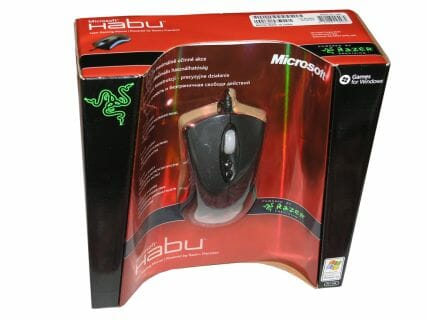
There is a mix of the two companies even in the design of the package. The box is shaped alike to the Copperhead box but is painted in Microsoft’s style with black-and-green specks of Razer.
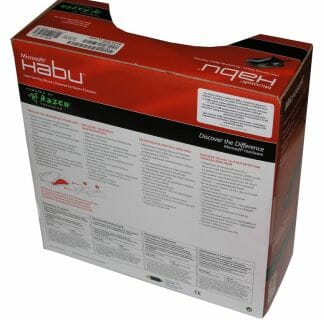
The box contains:
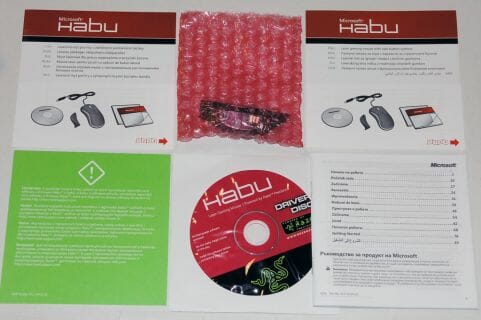
- Microsoft Habu mouse
- Alternative block of side buttons
- Two user manuals in several languages
- Getting Started booklet
- CD with software and drivers
Design and Ergonomics
After a detailed description of the Razer DeathAdder above there is little I can add about the Habu because the two mice are identical in terms of ergonomics. By the way, the specification and photograph of the device are enough to realize the contribution of each company to the end product: it is in fact a Razer Copperhead in the case of the Microsoft IntelliMouse Explorer 3.0.
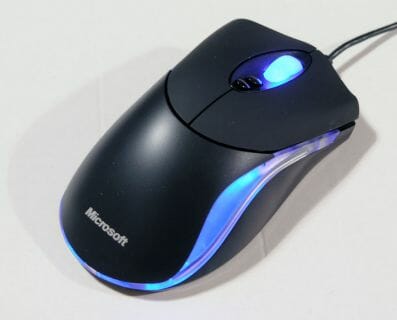
The Habu designed is closer to the classic mouse design from both manufacturers mixed up in equal measure: the buttons and sides from Razer and the overall case shape from Microsoft’s IntelliMouse Explorer. The Microsoft logo is even placed in the same way.
The side inserts are made of translucent rubber and serve not only aesthetic (blue LED-based highlighting is visible through them) but also utilitarian purposes, providing an anti-slippery support for your fingers when you lift the mouse up. This makes the Habu more convenient in this respect than the DeathAdder, especially as the case plastic of the Microsoft mouse is rougher and less slippery.
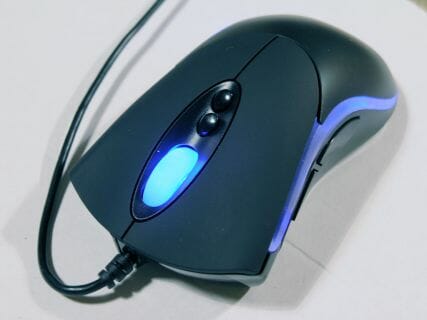
The main buttons are large and coated with the same material as is used on the DeathAdder (but fortunately, the most part the Habu case is free from that impractical coating). The buttons differ from the DeathAdder’s in characteristics. They have a sharper click, a longer depression distance, and a higher pressure effort.
The wheel is similar to the DeathAdder’s but smaller in diameter. It is shifted a little forward so as to leave room for two small round buttons. It is not convenient to use them during active play as you have to grasp the mouse in a different way or bend your fingers too much. On the other hand, these buttons will be helpful if you assign them some infrequently activated functions which you still want to have a means to control quickly or use them to switch between the mouse’s resolution modes, for example.
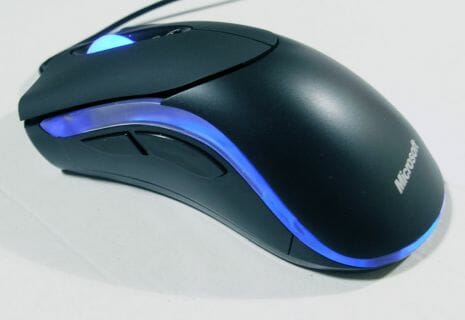
The side buttons are implemented in a very exciting way. An additional block of buttons is included with the mouse, where they are placed and shaped differently.
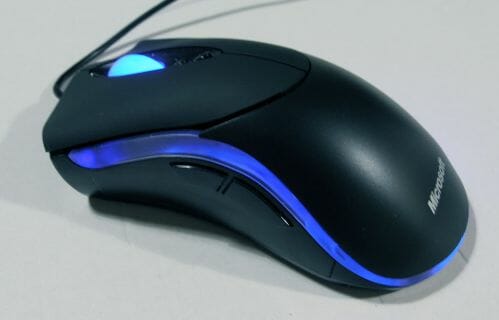
One block will suit people who have large palms or long fingers while the other (where the buttons are shifted closer to the rear) is for people with short fingers or who prefer to hold the mouse with fingers only.
Well, I still think that a gaming mouse should not have side buttons at all as there is always risk of your pressing them accidentally when you lift the mouse up above the pad. So, I never use such buttons and when I saw these customizable buttons I regretted they hadn’t included a blank block without any buttons at all. This was possible with the Copperhead using the optional Pro Tools, but you would lose your warranty after installing such a block.
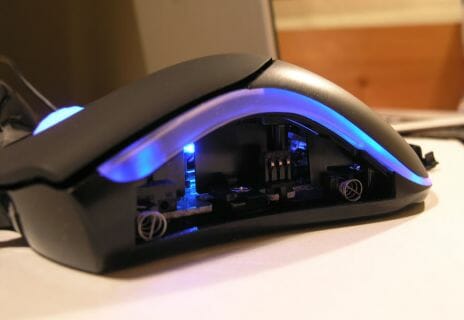
To replace the side panel, you should press the stiff button on the mouse bottom which will release a whole block at once:
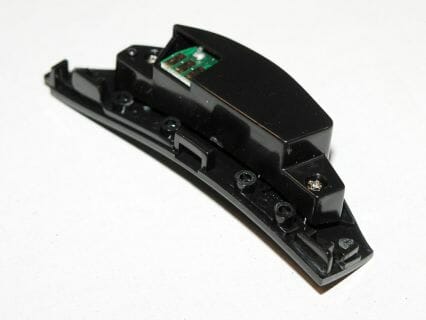
This block is put back by simply snapping it in place.
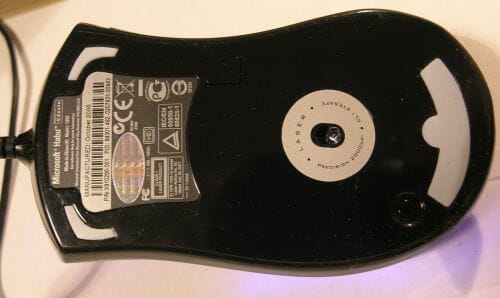
The mouse stands on three Razer-styled Teflon feet which are just the right height here. The sensor is shifted closer to the rear part of the mouse, which is not as good as the central position. There is also a button to switch between five settings profiles that can be stored in the Habu’s memory. The switching is indicated in the same way as on the DeathAdder.
What’s Inside?
As I wrote above, the Habu is a Copperhead in a different case. So, it cannot surprise you if you’re familiar with the specs and behavior of the latter. If you are not, I’ll tell you the main points.
The Copperhead was the first mouse from Razer to have 32KB of integrated memory for storing five settings profiles available even without installing the driver (the driver installation is an issue with the Habu).
Like the Copperhead, the Habu is based on the first laser sensor from Razer, with a resolution of 2000dpi. Razer’s has specific pros and cons of all laser-based sensors. It offers:
- Highest sensitivity (optical sensors haven’t yet hit 2000dpi)
- Excellent operation on smooth surfaces
- Small height sensitivity
On the downside, it has:
- Much worse, in comparison with high-quality optical sensors, maximum movement speed
- Poor operation on cloth or other rough-textured surfaces
As a matter of fact, the disadvantages of laser sensors are hardly perceivable for those who prefer high mouse sensitivity settings. Other gamers may find the mouse skipping even in simple gaming situations.
Software
The Habu’s USB connector is sealed with a green warning that you must install software from the included disc before connecting the mouse to your PC. This warning is not to be disregarded. Otherwise, “you’d want two university degrees to make out how to install the Habu driver” as someone wrote at a forum.
Strangely enough, the driver contains no mention of Microsoft. The Control Panel is designed in the Razer style and the mouse itself is called Razer Habu!
The Habu software doesn’t differ much from the above-described DeathAdder driver. You can define functions of all the seven buttons (the DeathAdder has five). The Glow-logo item is now called Glow-pipe. Instead of three resolutions you can choose from four now: 400, 800, 1600 and 2000dpi.
Summary
Razer may seem to have outwitted itself with the DeathAdder, having given the better device to Microsoft: the Habu has more buttons in total and allows replacing the side buttons. It has rubber inserts in the sides and less the destructible coating than on the DeathAdder. However, the laser sensor, despite the marketing advantage of a well-advertised technology, remains the weakest point of the Microsoft Habu, just like it was with the Copperhead. Well, The Copperhead has its admirers, too. So, if you’ve always wanted the Razer Copperhead but didn’t like its symmetrical shape, the Habu should suit you perfectly.
Highs:
- High resolution
- Integrated memory for storing settings
- Good buttons, especially the side ones
- Convenient shape (you’ll love it if you like the MSIE 3.0)
- Stylish design
Lows:
- Laser sensor doesn’t suit gamers who play at a low mouse sensitivity setting
- Buttons coating wears off with use
- Suitable for right-handed persons only
- Problems with installing the driver
Conclusion: DeathAdder vs. Habu
Telling you the truth, my first thought upon receiving the Habu (which was after I had used the DeathAdder for some time) and examining its design, specs and accessories was that Razer had outwitted itself and their best product was now selling under another’s brand. But I changed my opinion afterwards.
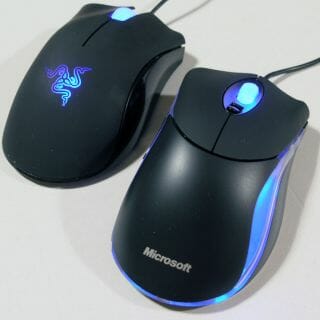
After comparing two such similar, but also such different, products, I strongly recommend the Razer DeathAdder for professional gamers. Just as I would have earlier recommended them to prefer the Diamondback to the Copperhead. It’s all about the innards: the 3G infrared sensor is a miracle whereas the laser sensor of the Copperhead/Habu can cause problems at sudden movements of the mouse.
On the other hand, if you just need a top-notch mouse for everyday work, or if you play games at a high sensitivity setting, the choice is not so obvious. I won’t judge the exterior design as this is a matter of personal taste and both devices are good in their own ways. The Razor has a somewhat more restrained appearance whereas the Microsoft looks more like a gaming product to me. The Habu has more buttons, a better coating, and customizable side buttons. The DeathAdder offers a more universal sensor, a legendary brand, and an eye-catching package design. The choice is yours.